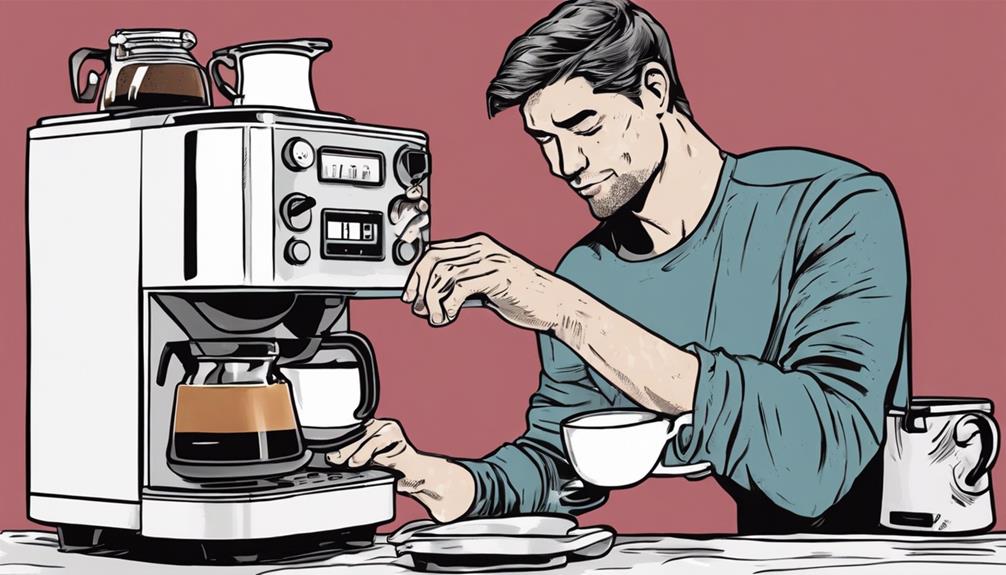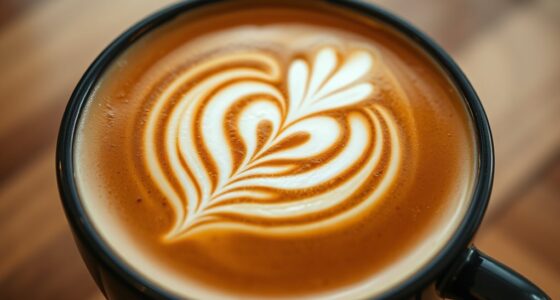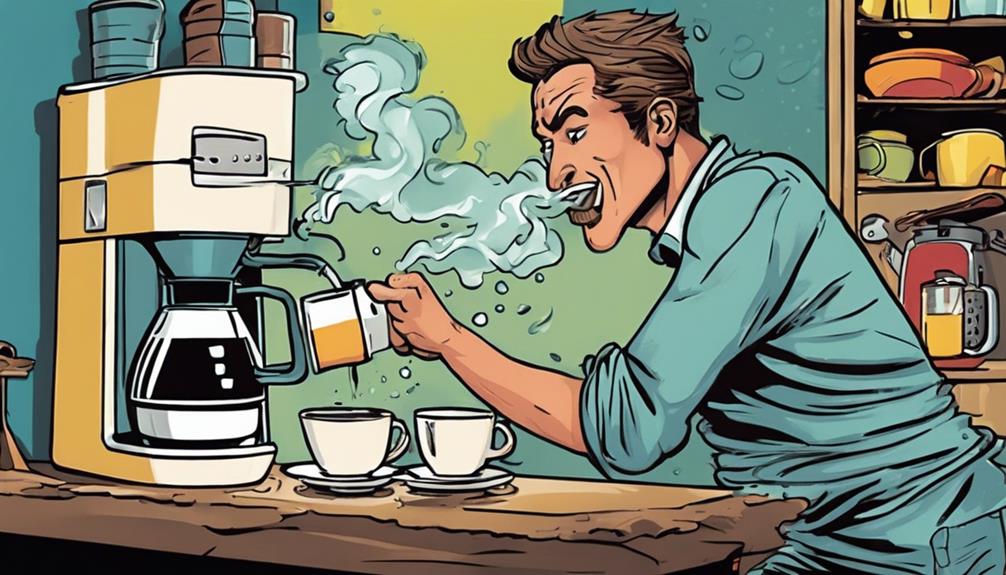To prepare 2 perfect cups of coffee, measure out 26g of medium-fine coffee grounds and 400g of hot water at approximately 200°F. Slowly pour the water over the grounds in a Hario V60 (02 size) with steady precision. Stir gently for optimal flavor extraction and strive for a balanced taste. Play around with grind size and brewing times to perfect your brew. Customize based on your liking and savor a flavorful, sweet coffee. Dive deeper into different brewing methods to elevate the subtleties and complexity of your 2 cups.
Key Takeaways
- Use 26g of medium-fine coffee grounds for 2 cups.
- Opt for a Hario V60 (02 size) dripper.
- Brew with 400g of hot water at 200°F.
- Maintain steady pour speed and thorough agitation.
- Experiment with grind size for flavor optimization.
Coffee Measurement Basics
To guarantee a perfect brew, measure your coffee accurately using one coffee scoop per cup indicated on your drip coffee maker's carafe. Each scoop typically holds about 2 tablespoons of ground coffee.
Remember that most coffee makers measure around 5 oz per cup, not the standard 8 oz, so adjust your coffee grounds accordingly. This adjustment is vital to achieve the right coffee-to-water ratio, which is recommended to be close to 1:18. The Specialty Coffee Association suggests using about 55 grams of coffee per Liter of water for an excellent brew.
When brewing two cups of coffee, that means you'd use two coffee scoops or around 4 tablespoons of ground coffee. Always keep in mind that different measurements of water are required for varying amounts of coffee grounds, so it's crucial to refer to the carafe's measurement markings for accuracy.
Coffee-to-Water Ratio Tips

When brewing your coffee, remember to be accurate with your coffee-to-water ratio for a balanced flavor profile.
Guarantee that you pay attention to the water temperature as it impacts the extraction process considerably.
Control the brewing time meticulously to achieve the desired strength and taste in your cup of coffee.
Ratio Precision Tips
For ideal coffee brewing results, aim to achieve a precise coffee-to-water proportion between 1:15 and 1:18.
To secure your coffee is brewed to perfection, consider these proportion precision tips:
- Grind Size: Adjust your grind size based on the brewing method you're using. For example, a finer grind is suitable for espresso, while a coarser grind works well for French press.
- Golden Ratio: The Golden Ratio of coffee-to-water is around 1:18, meaning 1 gram of coffee for every 18 mL of water. This ratio is a good starting point for a balanced cup of coffee.
- Amount of Coffee: Start with a 1:16 ratio (1 gram of coffee to 16 mL of water) and adjust according to your taste preferences. You can experiment with different proportions to find the perfect balance that suits your desired coffee strength.
Water Temperature Importance
Maintaining the perfect water temperature is essential for achieving the best flavor extraction when brewing coffee. The water temperature plays a pivotal role in determining the quality of your brew. For ideal flavor extraction, aim for a water temperature between 195-205°F.
Using water below 195°F can result in under-extraction, leading to a weak and lackluster cup of coffee. On the other hand, water that exceeds 205°F may cause over-extraction, resulting in a bitter taste. Ideally, a water temperature of around 200°F is recommended for brewing coffee, as it provides a balanced and flavorful cup.
Interestingly, at high elevations where water boils at around 204°F, it becomes an optimal temperature for brewing coffee. By ensuring that your water temperature is within the recommended range, you can elevate the taste of your coffee and enjoy a perfect brew every time.
Brewing Time Control
Control the brewing time by adjusting the coffee-to-water ratio for best flavor extraction. Finding the ideal coffee-to-water ratio is essential to a delicious brew.
Here are three tips to help you master this art:
- Ratio Range: Aim for a coffee-to-water ratio between 1:15 and 1:18. This range typically yields the best results in terms of flavor extraction and balance.
- Flavor Enhancement: Adjusting the coffee-to-water ratio can significantly impact the flavors in your cup. Experiment with different ratios to discover the nuances each one brings out in your coffee.
- Water Temperature Influence: Remember that water temperature also plays a vital role in the brewing process. Combining the right coffee-to-water ratio with the ideal water temperature will help you achieve the perfect extraction and enhance the flavors of your coffee.
Coffee Measurements Conversion Guide

Consider using a kitchen scale to accurately measure coffee grams for a precise brewing experience.
When it comes to coffee measurements conversion, understanding the relationship between grams of coffee and grams of water is essential for achieving that perfect cup.
A standard coffee scoop holds around 2 tablespoons of ground coffee, which is generally recommended as a single serving per cup. However, for more accuracy, you can convert this to grams, with approximately 5-6 grams per tablespoon depending on the grind size and roast level.
To maintain the ideal coffee-to-water ratio, which is typically 1 gram of coffee to 18 mL of water, using a kitchen scale can be extremely beneficial. This ratio ensures a well-balanced and flavorful brew.
Additionally, always be mindful of the measurement markings on your coffee maker's carafe, as they may not correspond to standard US cup sizes.
Coffee Maker Specifics – 10 and 12 Cup

When making coffee in a 10-cup maker, you'll need 1 ¼ cups of coffee grounds, while a 12-cup maker requires 1 ½ cups.
The weight equivalent for a 10-cup maker is 111 grams, and for a 12-cup maker, it's 133 grams.
Keep these quantities in mind when brewing your perfect pot of coffee.
Quantity for 10 Cups
Prepare 10 cups of coffee in your 10-cup coffee maker by using 10 scoops or 20 tablespoons of coffee grounds. For the ideal brew, measure out 111 grams of coffee grounds to achieve the perfect balance of flavor.
To make this process easier, here are some important steps to follow:
- Measuring the Coffee Grounds: Use a scale or measuring spoons to accurately portion out 10 scoops or 20 tablespoons of coffee grounds. This precise measurement guarantees a consistent taste with every brew.
- Water Quantity: Pour around 60 ounces or 7 1/2 cups of water into your 10-cup coffee maker. The right amount of water is essential for extracting the flavors properly from the coffee grounds.
- Grind Size: Adjust the grind size of your coffee beans to match the brewing time and flavor extraction needed for a 10-cup maker. The grind size impacts the extraction process, influencing the overall taste of your coffee.
Grounds for 12 Cups
To brew 12 cups of coffee in your 12-cup coffee maker, you'll need 12 scoops or 24 tablespoons of coffee grounds.
The recommended amount of coffee grounds for a 12-cup coffee maker is 133 grams when using a 1:16 coffee-to-water ratio. This guarantees a rich and flavorful brew that caters perfectly to the capacity of the coffee maker.
When preparing coffee for a larger group or when you need that extra kick to start your day, having the right amount of coffee grounds is crucial. By following these measurements, you can ensure a consistently delicious pot of coffee each time you brew 12 cups.
Remember that the quality and type of coffee grounds you use will also influence the taste of your coffee, so choose your favorite blend to suit your preferences.
Now that you know the precise amount of grounds needed, you can confidently brew a full pot of coffee in your 12-cup coffee maker.
Experiment Results and Adjustments

Upon analyzing the experiment results and adjustments, it was evident that doubling the coffee and water amount proved effective for brewing 2 cups of coffee.
To further enhance your brewing experience, consider the following adjustments:
- Adjust the Grind Size: Two clicks coarser resulted in a better extraction, ensuring a more balanced flavor in your cup of coffee.
- Increase Agitation during Blooming: More agitation during blooming led to a sweeter cup of coffee, enhancing the overall taste profile.
- Extend Brewing Time: Extending the brewing time by 30 seconds resulted in a thicker, sweeter cup of coffee. Longer brewing times enhance the flavor profile and sweetness, giving you a more robust coffee experience.
Brewing Time Adjustment Techniques

Adjusting the brewing time is essential for optimizing the flavors in your cup of coffee. To control the brewing time effectively, consider adjusting the grind size of your coffee beans. Using a burr grinder, you can fine-tune the coarseness to impact the brewing time. Each click coarser on the grinder can reduce the brewing time by 5-10 seconds, allowing you to match the total brewing time to the ideal length for your preferred cup of coffee.
Shorter brewing times typically result in a cleaner taste profile but may lack the full impact of flavors. To enhance the sweetness and fruitiness in your coffee, consider incorporating agitation and blooming techniques during the brewing process.
Experimenting with different brewing times will help you find the perfect balance that brings out the best qualities in the quality of your coffee. By adjusting the brewing time with precision, you can achieve a delightful and flavorful cup of coffee tailored to your preferences.
Final Recipe for Perfect Brew

How can you achieve the ideal brew for 2 cups of coffee using a Hario V60 (02 size) and 26g of coffee to 400g of water?
To create your perfect cup of coffee, follow these steps:
- Grind Your Beans: Start by grinding your coffee beans to a medium-fine consistency, similar to sea salt, to ensure best extraction during brewing.
- Make: Coffee: Place the V60 dripper on your mug or server, add the coffee grounds, and pour hot water (around 200°F) in a circular motion over the grounds. Allow the coffee to bloom for 30 seconds before continuing to pour in intervals, maintaining a steady pour speed and thorough agitation.
- Enjoy: After the water has dripped through the coffee grounds, discard the filter and grounds, and savor your perfectly brewed 2 cups of coffee with a rich, sweet flavor profile.
Adjusting the grind size and brewing time can further enhance your brewing technique for future cups.
Testing and Adjustments Process

During the testing and adjustments process, you refined the grind size and brewing times to achieve the ideal balance for your 2-cup coffee brew.
Initially, different grind sizes and brewing times were tested, revealing over-extracted results with a finer grind and a light-bodied outcome with a coarser grind.
The decision was made to double the recipe while adjusting the grind size 1-2 clicks coarser to achieve a more balanced 2-cup brew. As grind size was adjusted coarser, brewing time decreased, with each click resulting in a reduction of 5-10 seconds in brewing time.
Additionally, techniques such as agitation and blooming were found to enhance the sweetness and fruitiness in the final 2-cup coffee brew.
Frequently Asked Questions
How to Brew 2 Cups of Coffee?
To brew 2 cups of coffee, use 42g of medium ground coffee and 640g of water in a conical brewer at 93°F. Pour water slowly, starting with 120g, increasing steadily, aiming for a 3:00-3:30 brew time. Enjoy your perfectly brewed coffee experience. If you’re looking for a quicker cup of coffee, consider using speedy brew methods such as espresso or Aeropress. These methods can produce a delicious cup of coffee in a fraction of the time, perfect for those mornings when you’re in a rush. Experiment with different brewing techniques to find the one that best suits your taste and schedule.
How Many Scoops of Coffee for 2 Cups of Coffee?
You'll need two coffee scoops of ground coffee for 2 cups. Adjust for taste. Remember the coffee-to-water ratio. Experiment with different scoop sizes for your desired strength and flavor. Enjoy your perfectly brewed coffee!
What Is the Ratio for 2 Cups of Pour Over Coffee?
For two cups of pour-over coffee, the ideal ratio is about 26 grams of coffee to 400 grams of water. This translates to roughly 13 grams of coffee per cup, ensuring a well-balanced and flavorful brew.
How Much Coffee Should I Grind for 2 Cups?
You should grind around 26 grams of coffee beans for 2 cups. Experiment with grind sizes to tailor the flavor. Use a digital scale for precision. Adjust based on taste preferences and coffee-to-water ratio.
Conclusion
Now that you have mastered the art of brewing 2 cups of coffee, you're a coffee connoisseur extraordinaire!
Keep experimenting with different ratios and brewing times to find your perfect brew.
Remember, the key to a great cup of coffee is practice, patience, and a whole lot of love.
Keep on brewing, my friends, and let the coffee magic flow!









